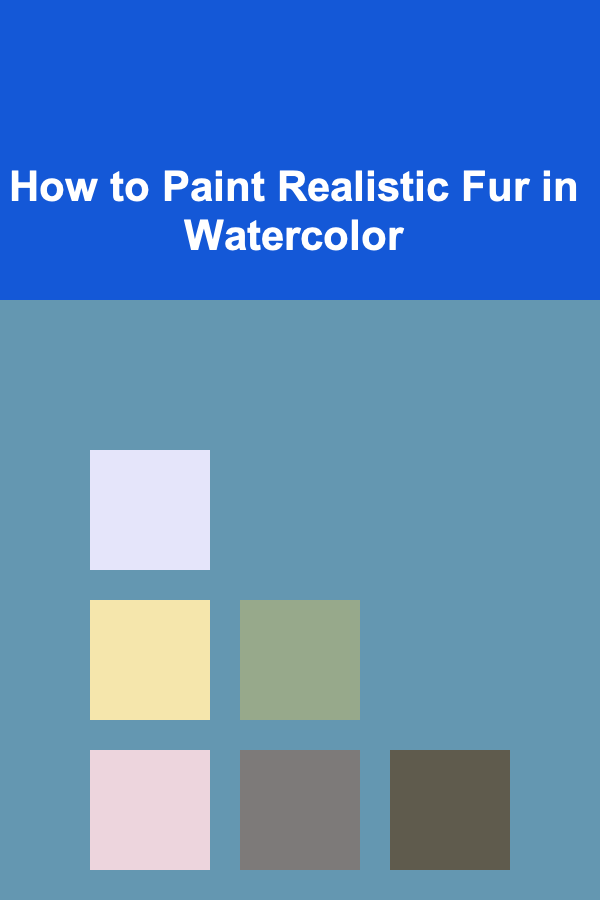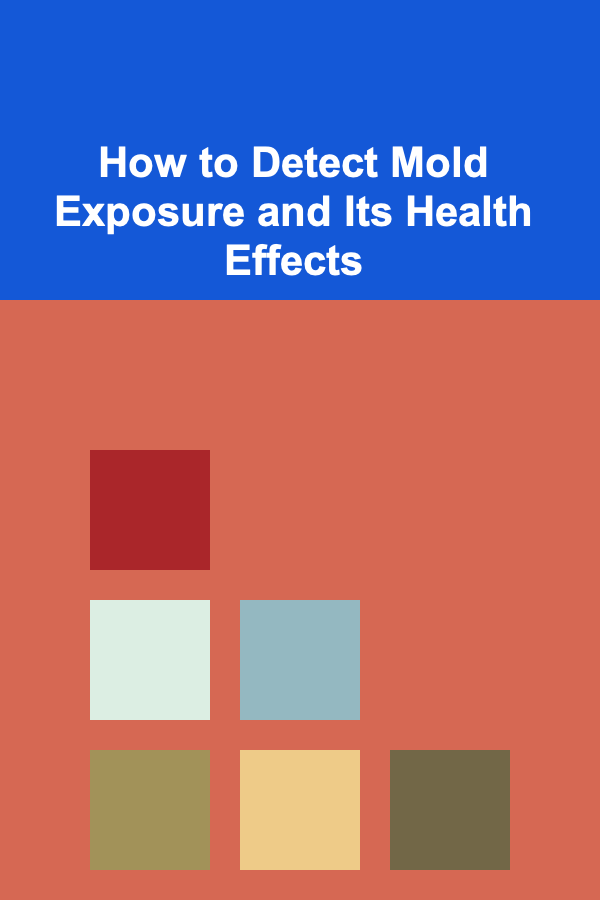
How to Paint Realistic Fur in Watercolor
ebook include PDF & Audio bundle (Micro Guide)
$12.99$6.99
Limited Time Offer! Order within the next:

Watercolor painting is known for its fluidity and transparency, often producing soft, ethereal effects. While these qualities can be challenging for artists who want to paint more detailed subjects, such as fur, they also present an opportunity to create realistic, lifelike representations when approached with the right techniques. Painting realistic fur in watercolor requires patience, an understanding of light, texture, and the behavior of water on paper. This guide will provide a comprehensive step-by-step approach to help you master the art of painting fur in watercolor.
Materials You Will Need
Before diving into the painting process, it's important to gather the right materials. Here is a list of essentials:
- Watercolor Paper: A good-quality, textured watercolor paper (preferably 300 gsm or heavier) is necessary for achieving the correct texture and handling the amount of water needed.
- Watercolor Paints: Choose professional-grade paints to ensure the vibrancy and richness of color. You'll need various shades of brown, black, gray, and white for fur.
- Brushes: A variety of brushes are needed for different stages. A fine detail brush (like a size 0 or 1) is essential for painting individual strands of fur, while larger brushes (size 6 or 8) can be used for broader strokes.
- Masking Fluid: Optional, but can be helpful for preserving the highlights in the fur.
- Pencil and Eraser: For sketching your subject before painting.
- Water and Palette: To mix and dilute your paints.
Understanding Fur Structure and Behavior
To paint fur realistically, it's crucial to first understand the way fur behaves. Fur is made up of individual strands that are connected to the skin. The texture and pattern of fur vary depending on the species of animal, the length of the fur, and how it's affected by lighting.
- Light and Shadow: Fur reflects light in various ways depending on the angle. The texture of the fur may cast shadows on itself, adding depth to the painting.
- Individual Strands: Fur isn't just one mass of color but is made up of individual, varied strands of hair that reflect light and shadow. These strands overlap and cross one another, so it's essential to show this detail without overcrowding your painting.
- Direction and Flow: Fur usually grows in specific directions, following the natural contours of the body. For instance, the fur on an animal's back typically flows downward, while the fur on its sides might flow toward the rear. The direction of the fur plays a huge role in how natural and realistic the painting looks.
Step-by-Step Process
Step 1: Sketching the Fur
Before painting, lightly sketch the outline of your subject, focusing on the general flow and direction of the fur. The sketch will serve as a guide, helping you place the individual strands of fur in the right areas. Use light, soft pencil strokes so you can easily erase or adjust as you go along.
- Mapping the Direction: Observe the direction in which the fur naturally flows. Use light, quick strokes to indicate this flow.
- Avoid Over-Sketching: A common mistake is over-sketching the fur. Since watercolor painting is about building layers, you don't need to draw every strand of fur in detail. Instead, focus on key areas where you need to understand the texture, such as the face, ears, or paws of the animal.
Step 2: Laying Down the Base Colors
The next step is to apply the initial washes of color. This stage doesn't focus on individual fur strands but on creating a base that will inform the layers of texture you will build later.
- Use a Large Brush: Start by using a larger brush (like a size 6 or 8) to cover broad areas of the fur. Begin with the mid-tones of the fur (usually browns, grays, or the animal's natural fur color). The goal here is to lay a foundation for subsequent layers.
- Wet-on-Wet Technique: Use the wet-on-wet technique, where you apply water to the paper before adding color. This technique helps create smooth transitions and can be ideal for creating the soft base of the fur.
Step 3: Building Layers of Fur Texture
Once your base layer is dry, it's time to start building up the fur texture. Use a smaller brush (sizes 1, 2, or 3) to add in more detailed strokes. The key to realistic fur painting is layering and creating depth with multiple layers of color.
- Dry Brush Technique: As you build texture, you'll want to use the dry brush technique. This involves using a slightly damp brush with more concentrated paint, then lightly dragging it over the paper's surface. This technique mimics the rough texture of fur and helps to form the individual strands.
- Color Variation: Fur is rarely one uniform color, so adding subtle variations in tone will make the fur look more realistic. Use a variety of colors such as browns, grays, yellows, and even blues or purples for shadow areas. Don't forget to leave some areas lighter where the fur is reflecting more light.
Step 4: Painting Individual Fur Strands
To make your fur look realistic, it's important to add fine details. The fur is made up of individual strands, and you'll need to carefully place these strands with a fine detail brush. The brush strokes should follow the natural direction of the fur.
- Focus on the Tips: Start by painting the fur's tips. The tips of fur strands are often lighter than the roots, and they catch more light. Lightly use a fine brush (size 0 or 1) to add these individual strands, following the fur's natural direction.
- Layering: Don't attempt to paint every single strand at once. Focus on building the fur in layers. Start with the darker areas and add lighter strands on top, working from dark to light.
- Contrast: Make sure to add enough contrast between the light and dark fur. Shadows and highlights are key to making the fur look three-dimensional and realistic.
Step 5: Adding Highlights and Details
At this stage, you can refine the fur by adding highlights and refining the individual fur strands. Use a clean, damp brush to pull out the highlights or use masking fluid in the beginning stages to preserve the areas that should remain light.
- Lift Paint for Highlights: To create lighter strands, use a clean, damp brush to lift some of the pigment from the paper. Gently blot the area with a tissue or towel to reveal the lighter fur.
- Use White Paint Sparingly: For highlights, it's best to use pure white watercolor sparingly. Sometimes, you may want to use opaque white gouache for very bright, sharp highlights, particularly around areas where the light hits the fur directly.
Step 6: Adding Depth and Texture
The final touches are what will truly make the fur pop. Adding depth and texture will bring the painting to life and create a more natural-looking appearance.
- Strengthen Shadows: Go over the dark areas with slightly more concentrated pigment to enhance the depth of the shadows. Fur creates interesting shadow patterns, especially where strands overlap or near the base of the fur.
- Refine Details: Revisit the fur texture and add more individual fur strands if necessary. Work in small, delicate strokes and focus on the natural flow of the fur to create a cohesive texture.
Step 7: Final Touches
Once you are satisfied with the fur texture and detail, step back and assess the overall painting. Look for areas that might need additional highlights or shadow work to enhance the realism. If necessary, go back in with a light wash to smooth any transitions or add a few more fur strands to refine the texture.
Tips for Painting Realistic Fur
- Patience is Key: Painting fur realistically can be a slow and meticulous process. Take your time and build up the layers gradually.
- Study Real Fur: The more you study real fur, the better you'll understand how to recreate it. Pay close attention to how light interacts with the fur, the way individual strands overlap, and how fur flows on different animals.
- Focus on Flow: Always focus on the natural flow of the fur. The direction in which the fur grows will guide your brushstrokes and enhance the realism of your painting.
- Don't Overdo the Detail: While it's important to create texture, don't overdo it. Too much detail can make the painting look busy and unnatural. Strive for balance.
- Use Glazing Techniques: In watercolor, glazing (applying thin layers of transparent color) can help deepen shadows and increase the richness of the fur.
Conclusion
Painting realistic fur in watercolor is a challenge that requires a combination of techniques, patience, and an understanding of the subject. By following the step-by-step process outlined above, you can create a lifelike, textured fur painting that showcases the delicate beauty of your subject. Whether you're painting a dog, cat, or any other animal, the key is to focus on layering, light, and texture, building up the fur strand by strand, and paying attention to the direction of growth and the way light interacts with it. With practice, your watercolor fur painting skills will continue to improve, leading to stunning and realistic results.
Reading More From Our Other Websites
- [Home Maintenance 101] How to Safely Move and Store Your Appliances
- [Personal Care Tips 101] How to Choose a Face Oil with Anti-Inflammatory Properties
- [Organization Tip 101] How to Create a Cozy Atmosphere While Staying Organized
- [Hiking with Kids Tip 101] How to Keep Young Hikers Motivated on Steep Elevation Gains
- [Personal Care Tips 101] How to Choose a Concealer with SPF to Protect Your Skin
- [Personal Care Tips 101] How to Choose a Toner for Sensitive Skin
- [Home Budget Decorating 101] How to Decorate a Kids' Room That's Both Fun & Budget-Friendly
- [Home Renovating 101] How to Create a Functional and Stylish Mudroom
- [Home Staging 101] How to Stage a Traditional Style Home with Modern Flair
- [Home Budget 101] How to Use Budgeting Apps to Track Home Expenses

How to Make Money Online as a Genealogist: 10 Actionable Ideas
Read More
Understanding the Philosophy of Consciousness
Read More
How to Design Web Banners and Advertisements: A Comprehensive Guide
Read MoreHow to Personalize Your Fertility Tracker Planner for Optimal Results
Read MoreHow to Automate Your Bank Fee Tracking Process
Read More
How to Detect Mold Exposure and Its Health Effects
Read MoreOther Products

How to Make Money Online as a Genealogist: 10 Actionable Ideas
Read More
Understanding the Philosophy of Consciousness
Read More
How to Design Web Banners and Advertisements: A Comprehensive Guide
Read MoreHow to Personalize Your Fertility Tracker Planner for Optimal Results
Read MoreHow to Automate Your Bank Fee Tracking Process
Read More